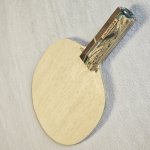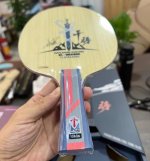This user has no status.
This user has no status.
Well-Known Member
Sorry for the "clickbait" title, I don't want to call you out actually. I am not blade maker just a player who has subjective opinions, but you have maybe hundreds of blade manufacturing behind you and can give good insight.
I am curious on your insight on recent Butterfly blades.(from the past 5-6 years)
Many people buy into that BTY has the highest possible quality. It is kind of undebatable that they drive the innovation of blades if it comes to special materials. But if you can debate it then please do since I would belive your insight over any corporate marketing BS.
As of late I have a problem with BTY blades. Whenever I try a Mizutani SZLC or Viscaria or some recently made Innerforce ZLC blade if I do flat hits or blocks the blade makes a weird sound and loses all power. By weird sound I mean a "pia" sound. 15 or 20 year old BTY blades don't have this issue.
I have tried Maze ALC and black tag TB Spirit, and they don't have any of this issue.
I have also tried several Chinese, Korean clones, they don't exhibit this "feature". So what is going on with Butterfly blades?
That being said no other blade feels so bipolar as Butterfly blades, newer BTY blades feel super dead and "pia" on over the table touches/blocks but come totally alive on topspin shots. I only experienced this defect/feature on BTY blades.
I would appreciate your opinion and also sharing who makes the most high blades nowdays. BTY, Xiom, DHS, Yinhe, You, OSP etc etc?
I am curious on your insight on recent Butterfly blades.(from the past 5-6 years)
Many people buy into that BTY has the highest possible quality. It is kind of undebatable that they drive the innovation of blades if it comes to special materials. But if you can debate it then please do since I would belive your insight over any corporate marketing BS.
As of late I have a problem with BTY blades. Whenever I try a Mizutani SZLC or Viscaria or some recently made Innerforce ZLC blade if I do flat hits or blocks the blade makes a weird sound and loses all power. By weird sound I mean a "pia" sound. 15 or 20 year old BTY blades don't have this issue.
I have tried Maze ALC and black tag TB Spirit, and they don't have any of this issue.
I have also tried several Chinese, Korean clones, they don't exhibit this "feature". So what is going on with Butterfly blades?
That being said no other blade feels so bipolar as Butterfly blades, newer BTY blades feel super dead and "pia" on over the table touches/blocks but come totally alive on topspin shots. I only experienced this defect/feature on BTY blades.
I would appreciate your opinion and also sharing who makes the most high blades nowdays. BTY, Xiom, DHS, Yinhe, You, OSP etc etc?














